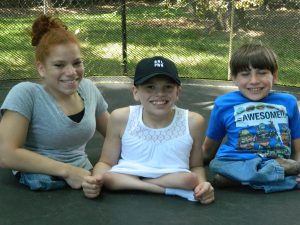
Disarticulation is a surgery that removes the lower portion of the leg at the knee joint. There is no cutting of bone involved and it is typically a short surgery with a rapid recovery time, especially when performed at a young age. It may be considered in cases where there is Buddha type sitting position with knees bent, joints fused, webbing behind the knees, and widely splayed knees, or straight leg position where knees can’t be bent and are long enough to then be in the way for attempting to sit. The surgery addresses several areas of concern for seating position, blood clot formation, independent mobility, and sometimes walking.
| Pro | Con
|
| Improved mobility and freedom of movement | Possible phantom pain-more frequently when surgery is done later in life than for young children |
| Improved self-care/dressing | People without disarticulations are typically still able to care for themselves even though dressing or mobility may be more cumbersome |
| Increased possibility of walking with prosthetics if that is important to the child or family- | Walking may not be important or may not be an option after disarticulation so that possibility doesn’t impact the decision. Use of prosthetics usually doesn’t continue into adulthood anyway |
| Addresses danger of blood clots and circulation issues early, before it becomes a life threatening emergency later | Some people prefer to wait until the issue of blood clots arises and then do the disarticulation because it doesn’t happen to everyone |
| Improved seating and fitting for wheelchairs- expensive specialized seating is not necessary. Wheelchairs don’t have to be extra wide for the adult, so access is easier. | Some people with SA/CRS use the ‘triangle’ of bent knees as a stable platform for sitting. There may be an adjustment to balance for sitting after disarticulation but this is usually a temporary issue |
| Addresses the problem of cumbersome width of wheelchair that accommodates widely spread knees, meaning that the chair can now fit through doorways and bathroom stalls whereas when it is extra wide it won’t fit. | For some children, with feet crossed, there is not a width issue. (difficult to predict what the width requirement will be for the adult |
| The surgery is not major-no cutting of bone involved.
|
Some people are very sensitive to the idea of changing the way the child was born and feel strongly that surgery should not alter a physical feature. |
| Less wear and tear on shoulders from carrying the ‘weight’ of the legs | Shoulder issues may still develop, especially if the person is overweight as an adult |
| Every surgery carries some risk. | Not doing the surgery also carries some risk (blood clots/pressure sores, etc.) |
| If there is increased sensitivity in the legs –pain when touched, etc., then the disarticulation relieves that problem | There is a slight risk of phantom pain after surgery (not common, and especially not common for young children) |
| Nobody really sees the typically small legs anyway | Some people are very sensitive to the idea of having an ‘amputation’ or being an ‘amputee’ |
| You don’t have to worry about shoes or clipping toe nails anymore | Some people really want to be able to put shoes on their feet and enjoy wearing shoes even if they don’t walk |
| For children with straight “fused” legs that don’t bend, it’s easier to ‘sit’ without the legs being in the way, both in wheelchairs and on places like airplanes or buses | Some children use straight fused legs to ‘stand’ and want to maintain this function even if it means sitting is a problem. Some children grow to adulthood and the legs are so short that seating is not so much an issue as it is when the legs are longer |
| As an ‘amputee’ there are sometimes additional services, scholarships, or opportunities available that the child can receive | These opportunities may not be a high priority for the child or family and certainly not a prime reason to do disarticulation |
